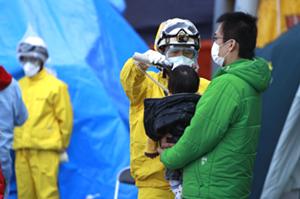- Blog
- Food & Agriculture
- FAQ on the Nuclear Reactor Crisis in Japan
FAQ on the Nuclear Reactor Crisis in Japan

Donate Now!
Your contribution will benefit Friends of the Earth.
Stay Informed
Thanks for your interest in Friends of the Earth. You can find information about us and get in touch the following ways:
Friends of the Earth received many questions and comments regarding the unfolding nuclear disaster in Japan. We have compiled several of those questions and will be adding more to this page as more questions come in or as the situation changes in Japan.
You can always contact us with more questions by visiting /contact-us
You can find more updates and information on the nuclear crisis in Japan by visiting /news/archives/2011-03-the-nuclear-crisis-in-japan
March 15, 2011
Question: What are the chances of contamination on the West Coast? How could it change?
Answer: Experts we are working with agree that even with a full-scale meltdown, the chances that large amounts of radioactive contamination from the nuclear reactors in Japan would reach the West Coast and Hawaii would be slim. “I think the chances of us having a major exposure here in the U.S. is not real high, but the problem is we still don’t know what’s happening,” said Dr. Ira Helfand.
Because of the nature of this type of contamination, there are many factors to consider – wind speed, clear sky or rain, and fire – when trying to model the amount of radiation distribution. There are no certainties, but at present, there is no need for those in the U.S. take specific preventative measures. The story is very different for the people of Japan. We will continue to monitor this issue and provide updates as merited.
Question: Is the Japanese government downplaying the severity because they don’t want the public to panic?
Answer: The Japanese government and nuclear industry have downplayed the severity of nuclear problems in the past. We don’t know the exact motivation for their current behavior. It could be that they are motivated by a desire to keep the public from panicking, or to protect the reputation of the nuclear industry, or because they themselves don’t have all the information. What we know is that all governments need to be transparent with their citizens, not only about nuclear reactors but about any environmental disasters that could put citizens at risk.
Decades of downplaying the risks of nuclear power have allowed reactors to be built and operated for too long. And as the events in Japan are demonstrating, that’s very dangerous.
Question: Isn’t this problem isolated to Japan’s type of reactors? How could this happen here?
Answer: The specific set of problems happening in Japan could also happen in the U.S. We too are operating this type of reactor and others which are old and/or have known problems.
While the tragedy that is unfolding in Japan is the result of a unique set of circumstances, the risks associated with nuclear reactors are the same everywhere. Nuclear reactors are complex systems that cannot simply be shut down in the event of a disaster because they require constant, and massive, amounts of water and electricity for days after they stop producing electricity. Additionally, large amounts of water and electricity are required to protect spent fuel (rods no longer in service) for years after it is used. Ultimately, nuclear reactors are machines, and all machines breakdown and fail. In addition, human error has also played a major role in nuclear accidents.
Once things go wrong at a nuclear reactor there is the potential for catastrophic outcomes unlike those from any other energy source. Unfortunately, we are seeing that potential in Japan right now, just like we saw at in Chernobyl and at Three Mile Island before it.
